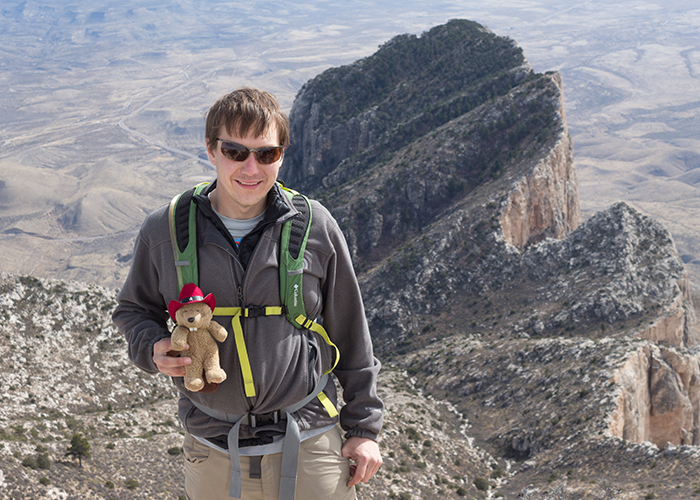
You wouldn’t expect to meet a cave enthusiast 8,000 feet above ground, but that’s just what happened when I tackled Guadalupe Peak, the highest in Texas. As I stopped to snap some photos, the chairman of Montana’s Northern Rocky Mountain Grotto caught up and we chatted all the way to the summit.
Ian Chechet loves caves! His adventure began in 2011 (a great year for adventures to begin), when a blizzard kept him from reaching a summit in the Pryor Mountains near Cody, Wyoming and forced him, instead, to check out the exquisite Big Ice Cave. The splendor of that cave led him to seek out more, and eventually, to link up with like-minded folks who wanted to discover the wonders underground.
“My first time meeting cavers was at a Rocky Mountain Regional in South Dakota, and I realized that all of these people were a little bit off, just like me. I think that all cavers are their own types of nerds. You’ve got bat nerds and geology/rock nerds, and computer nerds. Caving attracts people that are a little bit nerdy. And it’s really fun.”
It was this sense of camaraderie that led Ian to join the Northern Rocky Mountain Grotto, Montana’s 200-member chapter of the National Speleological Society (NSS). The Grotto’s mission is to explore and map new caves around the country. They’ve discovered ancient baskets and 12,000 year old giant sloth poo in caves at the bottom of the Grand Canyon. Closer to home, the Grotto was the first to map Tears of the Turtle, the deepest known cave in the United States. Just to get there, the Grotto crew had to trek 22 miles through the Bob Marshall Wilderness then clamber 1,629 feet down into the depths, using a passage that was mostly two feet wide.
“I spent three days underground in Tears of the Turtle in 2016 exploring the edge of the cave. […] It was pretty scary because in some of these cracks, if you fall down and get wedged, there’s really not an easy way for you to get out. We’re always with other people, but they’ve got no purchase up there. They couldn’t pull me up. What are they gonna grip onto?”
Despite the dangers, Ian estimates that he has explored over 200 caves, collecting data along the way. Using a compass, an inclinometer, and a laser distance measurer, the Grotto team establishes points, measures the spaces between those points, and connects them. It’s like connecting the dots to piece together a 3D puzzle!
Once the Grotto team has mapped out the routes and the mineral and biological resources, they share it! State and federal agencies, who are already overwhelmed and may not be well versed in cave resources, welcome the information that these intrepid explorers provide. This helps organizations like the National Park Service come up with management plans for the fragile caves under their care.
“Within 30 days of a caving trip, you’ll submit a trip report and share that information with the Forest Service and the BLM. They actually support us. They’ve sponsored us purchasing cave gear to take new members and out-of-state cavers into caves, so if people come to Montana, we don’t have to worry about them bringing gear that may be infected with white-nose syndrome.”
White-nose syndrome is a fungal disease that has devastated bat populations across the country. Though it mainly spreads from bat to bat, it was first introduced to American caves by a spelunker from Europe, where it is native. It only took ten years for the disease spread across 31 states and five Canadian provinces, killing over seven million bats! To Ian’s girlfriend, a bat biologist dating a cave expert, it’s been especially devastating.
“In some parts of the country, caving in public caves has been almost entirely eliminated. When white-nose syndrome hit, all the federal caves in the southeast were closed, and most of them still are.”
To slow the spread of a seemingly unstoppable disease, the Grotto puts a good deal of energy into education. They not only teach members and guests about the importance of decontamination, but they also support programs like the Bigfork High School Cave Club, which takes students into the depths to explore the treasures of Montana’s cave system and learn how to protect them.
“Some of these kids will start as freshmen completely missing their cell phones and bummed out that they have to go out into the woods at all, and by the end of it, they’ve got careers with [the United States Geological Survey] because of it.”
The Grotto welcome new members, and joining a Grotto is the best way to support their work. Unlike some caving organizations, which won’t take you into a cave until you’ve been to a year’s worth of meetings, the Grotto schedules cave trips for new members every one to two months. They have one official meeting a year and a bunch of informal pub nights held at bars and restaurants across the state. Their only requirement for members: when you come back above ground, share your findings.
“So many doors have been opened to me through [the Grotto]. Now I get to lay out the pathways people will use for the rest of time.”

To help the helpers at Northern Rocky Mountain Grotto:
- Join them at NRMG.org!
- Find and join your own local Grotto!
- Donate to the National Speleological Society!